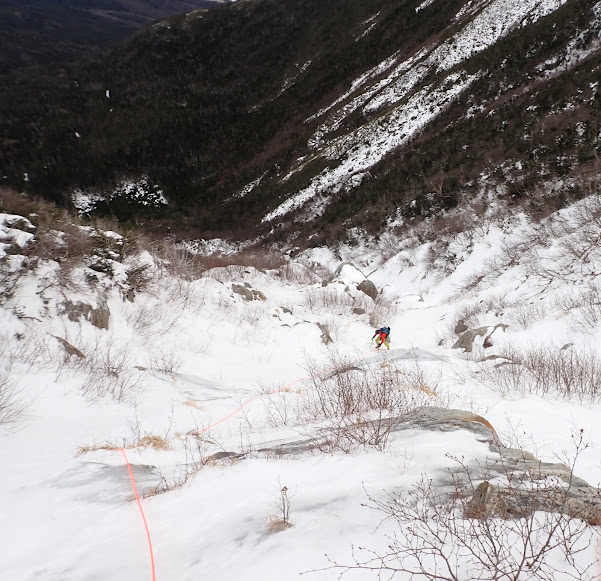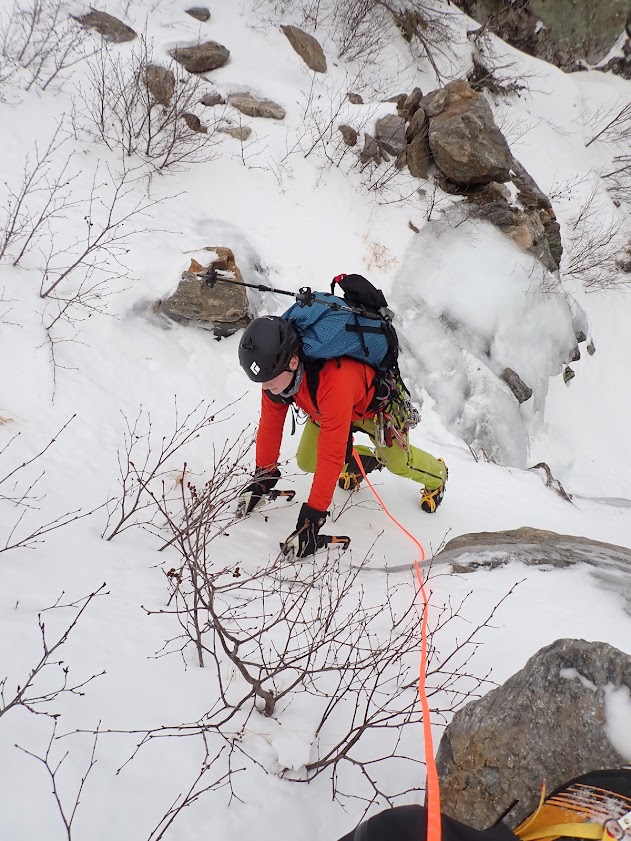My 15-year old partner (and son) Tobias and I went up to New Hampshire's legendary Mt. Washington for some early season alpine action. Although an increasingly-common low tide year (until just after our mid-December trip), we had good conditions for what we were looking to do. We have been to Tuckerman's Ravine several times in the spring for ski mountaineering, and I have climbed in Huntington Ravine over many years and routes. But Tobias had never done an alpine route, and that was the objective for this trip. We were supposed to have a third, which I favor when venturing into technical terrain, but poor health intervened and it turned out being just the two of us.
The approach went a bit faster than usual, due to the lack of ski gear and perhaps better fitness, or that's what Tobias said of my performance. Given the rare compliment I'll take it. We did not leave Pinkham Notch until about 1pm on a Saturday and made it to the Hermit Lake area in about 2 hours and 20 minutes with packs weighing in at just under 40 pounds. We dropped camping gear in a lean-to and hiked up to the base of the bowl in Tuckerman's ravine. Compared to our spring trips it was bone dry, but the standard wealth of early-season ice was there, and we discussed what route options would be best for our outing the next day. While Tucks had Open Book and some pitch-long ice left of Left Gully, Tobias was hankering to get back over to Hillman's. We had heard from a descending soloist that it was in good condition, and we'd topped out just below the lip last April due to my failure to bring crampons (never again.)
Camping was enjoyable if cold, with the windless night coming in about zero Fahrenheit. The highlight was when it was discovered that I'd not only failed to charge my headlamp but lost my backup. Tobias only crowed a little when his backup saved my bacon. The next morning we started later than we planned because even with 11 hours of sleep I neglected to remember that the alarm on my phone was not likely to work if said phone was off, another chestnut for the young man. But we started out at 7 and headed over to Hillman's. The bottom was dry with audible water beneath, and the first several hundred feet passed smoothly under us with increasing neve and less bushwhacking as we rose higher. Finally, about halfway up, Tobias wisely asked for the rope and we tied in and started pitching out the top half of the route.
There were a few ice bulges but most of the route was very firm neve, and until the last few hundred feet the belays were acceptable. A couple of screws for the first one, some slung bushes one might call trees, a semi-hanging belay from a rock anchor and one final rock thread created by beating a few rocks down on the lad.
As we neared the top there was some flagging, but we were steady if slow at our pace. We probably started climbing around 8 and topped out around noon, about an hour after my target time for safely continuing to the summit, another cause for Tobias to crow about due to the late start. But in fact the cloud cover was only a couple of hundred feet about the lip, and it was not the right day for the summit, which I have never visited. We started contouring around the lip of Tucks heading for the Tuckerman Ravine trail.
The view down into Tucks was a bit sobering, and since neither of us had been up the trail we opted for Lion Head which I'd travelled many times.
We got down it keeping crampons on the entire way, but there were only a few patches of ice and it would have been viable with microspikes as on the approach. We picked up our camping gear, grabbed a last look at the ravine and headed down for the long drive home in a light lovely snow.

















